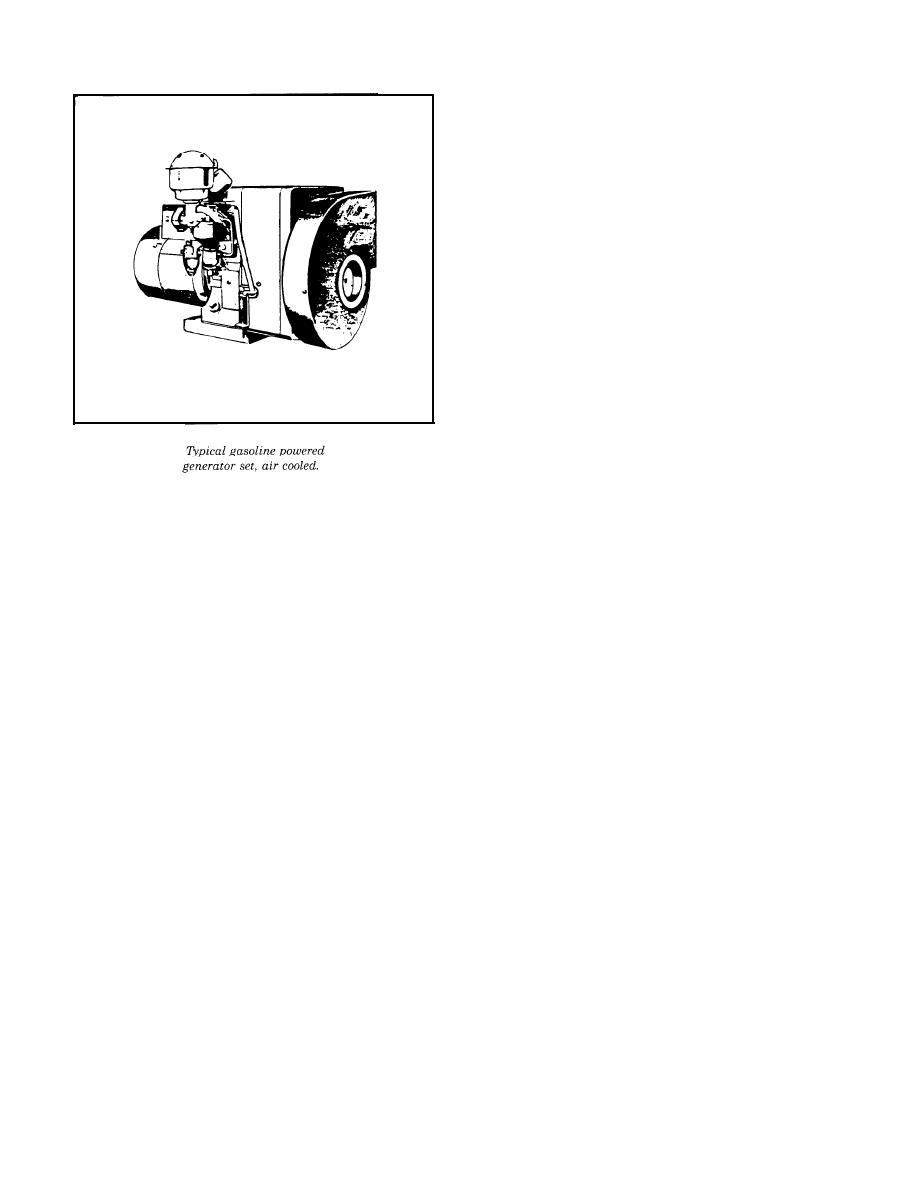

Custom Search
|
|

|
||
 T M 5-685/NAVFAC MO-912
(d) High efficiency up to rated load.
(4) The disadvantages of using a gas turbine
are:
(a) Initial cost is high.
(b) Fuel and air filtering are required to
avoid erosion of nozzles and blades.
(c) Fine tolerance speed reducer between tur-
bine and generator is required and must be kept in
alignment.
(d) Specialized maintenance, training, tools
and procedures are required.
(e) Considerable energy is required to spin
for start.
(g) Exhaust volume is considerable.
(h) A large portion of the fuel heat input is
used by the compressor.
(i) A long bedplate is required.
(j) Maximum load is sharply defined.
(h) Efficiency is lower than reciprocating en-
emergency
Figure 3-l.
gines.
c. Rotary spark ignition engines. These engines
b. Gas turbine engine. The fuel and air burn in a
are typified by the Wankel-type engine operating on
combustion chamber in the gas turbine engine. The
the Otto principle. Each of the four cycles occurs in
a specific sector of an annular space around the axis
resulting high-pressure gases are directed through
of the shaft. The piston travels this annular cham-
nozzles toward the turbine blades and produce work
ber and rotates the shaft. The power stroke occurs
by turning the turbine shaft. This is a continuous
once in every shaft revolution, dependent on the
process in the continuous-combustion or constant-
__
design of the engine. This engine can produce a
pressure gas turbine.
large amount of power for a given size. The high
(1) Gas tu rb ines operate on the Brayton Cycle
rpm, low efficiency, friction and sealing problems,
principle. While a number of configurations are
and unfavorable reliability of this engine make it
used for aircraft propulsion (turbofan, turboprop,
unsatisfactory as a prime mover for auxiliary gen-
etc.), the one used as a prime mover for auxiliaries
erators. These faults may be corrected as the devel-
is generally the continuous combustion gas turbine.
opment continues.
In this process, air is compressed by an axial flow
compressor. A portion of the compressed air is mixed
3-2. Diesel engines.
with fuel and ignited in a combustion chamber. The
Diesel engines for stationary generating units are
balance of the compressed air passes around the
sized from 7.5 kW to approximately 1500 kW and
chamber to absorb heat, and then it is merged with
diesel engines for portable generating units are
the burned products of combustion. The pressurized
sized from 7.5 kW to approximately 750 kW. See
mixture, usually at 1000F or higher, flows into a
figures 3-2 through 3-4. Efficiency, weight per
reaction turbine.
horsepower, and engine cost relationships are rela-
(2) The turbine drives the compressor and also
tively constant over a wide range of sizes. Smaller
produces work by driving the generator. A portion of
engines, which operate in the high-speed range
the exhaust gas may be recirculated and it is pos-
(1200 and 1800 rpm), are used for portable units
sible to recover heat energy from the waste exhaust.
because of their lighter weight and lower cost. Low-
The compressor uses a relatively large portion of
and medium-speed (200 and 900 rpm) engines are
the thermal energy produced by the combustion.
preferred for stationary units since their greater
The engine efficiency is highly dependent on the
weight is not a disadvantage, and lower mainte-
efficiencies of the compressor and turbine.
nance cost and longer life offset the higher initial
(3) The advantages of using a gas turbine are:
cost.
(a) Proven dependability for sustained op-
a. The advantages of diesel engines include:
eration at rated load.
(1) Proven dependability for sustained opera-
(b) Can use a variety of liquid and gaseous
tion at rated load.
fuels.
(2) Efficiency.
(c) Low vibration level.
3-2
|
 
|
|
 |
||